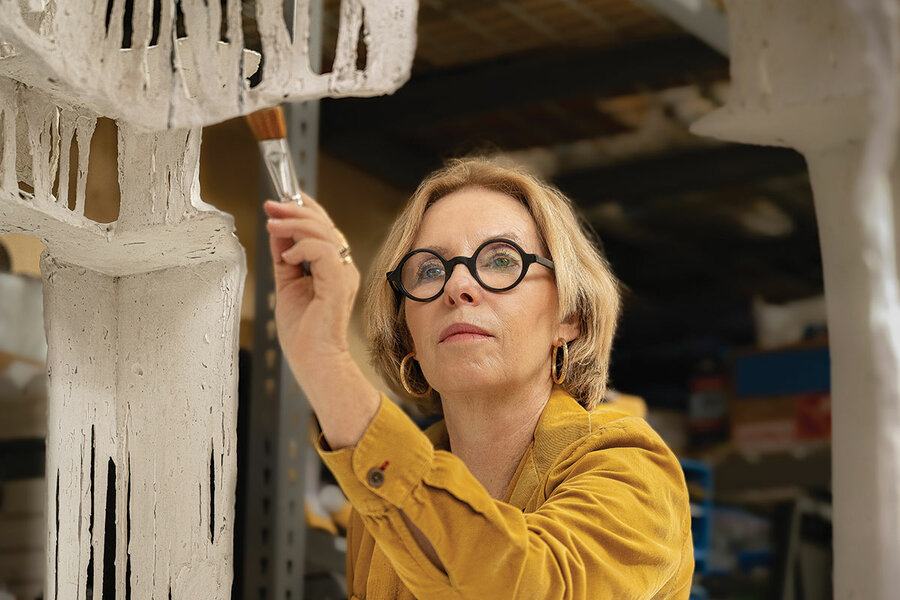A poignant memoir unfolds the struggle of Cuban Jewish exiles
Loading...
Throughout “Dwell Time: A Memoir of Art, Exile, and Repair,” noted art conservator Rosa Lowinger illuminates the principles of her field. Conservation is “fundamentally the art of understanding damage,” she observes. “You can’t repair what you don’t comprehend.” Elsewhere, describing works of art with intrinsic defects, she writes, “A conservator can’t reverse such damage; she can only manage it.” Another lesson from her decades of experience: “There are hardly ever perfect solutions.”
Lowinger’s painstaking work restoring sculpture, artifacts, and historic architecture yielded these insights. In her beautifully crafted memoir, she applies them not only to her profession but also to her fraught relationships with her Cuban Jewish parents. The result is both cerebral and deeply moving.
“Dwell Time” begins with the stories of the author’s mother, Hilda, and her father, Lindy, both born in Cuba in 1932. Hilda and Lindy were each children of Jewish immigrants; their parents had fled the poverty and persecution of their Eastern European homelands during the 1920s, a period when antisemitism and nativism led the United States to curtail immigration from the region. Blocked from entering America, thousands of Jewish immigrants ended up settling in Cuba instead.
Hilda’s mother died shortly after Hilda was born. The girl spent part of her childhood in an orphanage in Havana and part with her unreliable father, who struggled with alcoholism. Lindy’s father, meanwhile, was a successful merchant, and his family was stable and comfortable. Lindy, kind and soft-spoken, fell in love with the beautiful, green-eyed Hilda, and they married in 1955 despite his parents’ disapproval; not only was Hilda poor, but she was also hot-tempered and unpredictable.
The author was born the following year. When Fidel Castro seized power in 1959, Lowinger’s family agonized over what to do. “They stayed in Cuba for another two years, watching their country devolve from a freewheeling dictatorship into a frighteningly rigid totalitarian system,” she explains. They finally fled Cuba in 1961, days after the U.S. broke off diplomatic relations with the island. “It would be the last time my parents would see their homeland,” Lowinger writes.
Like many Cuban exiles, the Lowingers settled in Miami. They’d been forced to leave most of their belongings and assets behind in Havana, so they crowded into an apartment near the beach. Hilda became erratic and violent, and, Lowinger recalls, “our days were marked by her moods.”
As a girl, Lowinger was the most frequent target of Hilda’s abuse. “Exile was driving her crazy,” the author writes. “And I received the brunt of her insanity.” Her mother hit and pinched her and pulled her hair. If Lowinger didn’t finish her dinner, Hilda dumped the remaining food onto her head.
The author applied to out-of-state colleges to escape her family. She attended Brandeis University, outside Boston, where she initially studied sculpture and printmaking. After being captivated by a medieval art history class, she ended up pursuing art conservation instead. In the ensuing years, she rose in her profession, married, and started a family in Los Angeles. Even so, her formidable mother retained a strong grip on her.
After the collapse of the Soviet Union in 1991, Lowinger began traveling to Cuba, where she encountered “so much wreckage mixed with so much beauty.” She explains the country’s appeal to conservators: Because there was no private property during the Castro regime, there was no incentive for real estate speculation. Historic properties were deteriorating, but they were intact, ripe for restoration.
Of course, working in Cuba was especially meaningful to Lowinger because of her heritage. Over time, as she demonstrates, her experiences there helped her better understand her parents and, ultimately, herself. Indeed, she writes about her parents with compassion, acknowledging that there was love and kindness amid the instability of her family life. “It was hard to see it, just as it’s hard to notice anything but the dents and cracks and gouges in an otherwise beautiful sculpture,” she observes, deploying another apt metaphor from her field.
How fortunate for Lowinger that she fell into a career that not only provides her with deep satisfaction but also has helped her excavate and mend her own past. Fortunate, too, for readers that she decided to write it all down.








